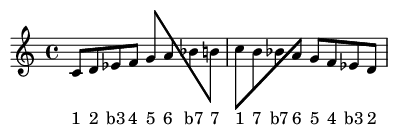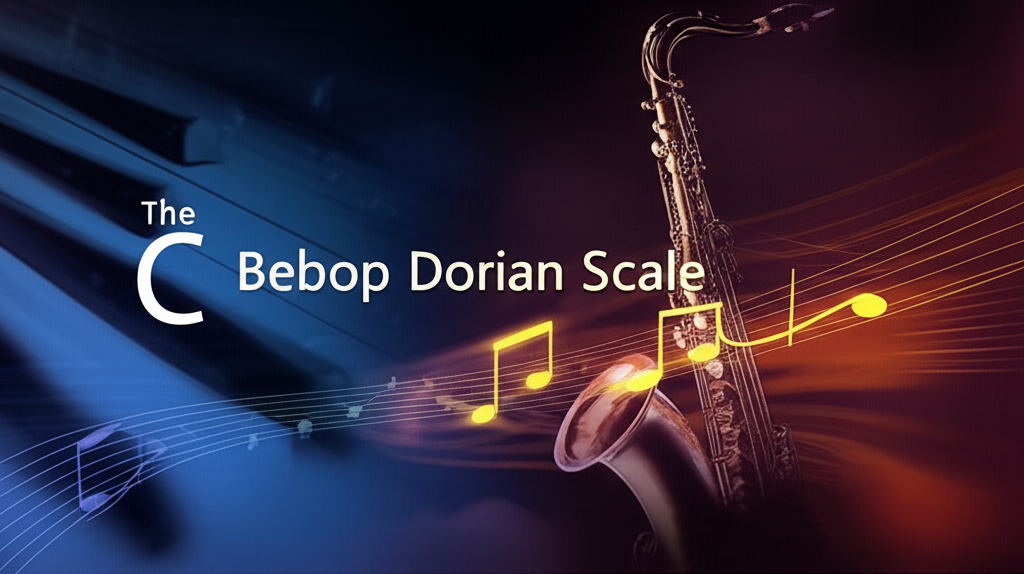Summary:
Dive into the world of jazz improvisation with the Bebop Dorian scale. This essential eight-note scale is a powerful tool for navigating minor chords with the authentic sound of bebop. This article breaks down its unique structure, demonstrates its practical application over common chord progressions, and provides you with the knowledge to incorporate its smooth, melodic flow into your own solos.
Keywords:
Bebop Dorian Scale, Jazz Scales, Improvisation, Music Theory, Bebop, Dorian Mode, Jazz Education, Chromaticism, Passing Tones, Barry Harris
Introduction:
Have you ever listened to a classic bebop solo by Charlie Parker or Dizzy Gillespie and marveled at how their lines flow so effortlessly over the chords? A key part of that magic lies in their masterful use of chromaticism. Bebop scales are the secret sauce that helps improvisers connect chords smoothly and rhythmically. Among these, the Bebop Dorian scale is your go-to device for adding sophistication and melodic logic to your lines over minor chords. Let's explore this versatile and essential scale.
What is the Bebop Dorian Scale?
The Bebop Dorian scale is an eight-note scale, which distinguishes it from the standard seven-note diatonic scales. It's constructed from the Dorian mode by adding one chromatic passing tone. The formula for a standard Dorian scale is: 1, 2, b3, 4, 5, 6, b7.
To create the Bebop Dorian, we add a major 7th (7) as a passing tone between the flat 7th (b7) and the root (1). This gives us the formula: 1, 2, b3, 4, 5, 6, b7, 7.
For example, a C Dorian scale is C-D-Eb-F-G-A-Bb. The C Bebop Dorian scale adds a B natural, resulting in: C-D-Eb-F-G-A-Bb-B. The purpose of this extra note is purely functional: it ensures that when you play the scale in descending eighth notes, the primary chord tones of the corresponding minor chord (1, b3, 5, b7) land squarely on the strong beats, creating a powerful harmonic alignment.
Examples:
C Bebop Dorian Scale (Ascending & Descending)
Here is the C Bebop Dorian scale written out. Notice the added B natural (the major 7th), which acts as a chromatic passing tone leading from the b7 (Bb) back to the root (C). The scale degrees are included as lyrics to help you see the structure.

Example Lick: Descending Line Over Cm7
Here is a classic melodic phrase over a C minor 7th chord (Cm7) using the descending C Bebop Dorian scale. Listen to how the chord tones of Cm7 (C, Eb, G, Bb) fall perfectly on the strong beats (1, 2, 3, and 4) thanks to the passing B natural.
Practical Applications: Where to Use It
The Bebop Dorian scale is a natural fit over any minor chord that functions in a Dorian context. Its prime applications are:
- Over the ii chord in a ii-V-I progression: In a major key, the ii chord is minor and functions as a Dorian sound. Using the Bebop Dorian scale creates flowing lines that lead smoothly into the V chord.
- Over the i chord in a minor key blues or modal tune: In tunes where the tonic minor chord has a Dorian quality (like "Oleo" or "So What") , the Bebop Dorian scale is the perfect choice.
- Over the iv chord in a major key: The iv chord (e.g., Fm7 in the key of C Major) also often takes on a Dorian sound, making it a great place to apply this scale.
Example: Lick over a ii-V-I Progression
Let's look at a ii-V-I in C Major (Dm7 - G7 - Cmaj7). We will use the D Bebop Dorian scale over the Dm7 chord. Notice how the descending line (D-C#-C-B-A-G-F-E) places Dm7 chord tones (D, F, A, C) squarely on the downbeats, before landing on B, the 3rd of G7, to begin the next phrase.
Historical Figures and Codification:
While the bebop pioneers of the 1940s and 50s may not have used the term "Bebop Dorian Scale," their playing is the source from which this theory was derived. Charlie Parker and Dizzy Gillespie's solos are rich with chromatic passing tones used in exactly this manner to outline chord changes. However, the concept was largely codified and popularized by the legendary jazz pianist and educator Barry Harris. Harris developed a comprehensive system of improvisation based on "scales of chords," teaching generations of musicians how to use these eight-note scales to navigate bebop harmony with precision and creativity. His teachings have made these advanced concepts accessible to students worldwide.
Fun Facts: The "Magic Note" and Diminished Harmony
The added chromatic note in any bebop scale is often called the "magic note." Why? Because it magically solves the rhythmic problem of fitting a seven-note scale over a four-beat measure. By adding an eighth note, it creates a perfect alignment where chord tones land on strong beats and non-chord tones land on weak beats in descending eighth-note lines.
Another fascinating aspect is the scale's connection to diminished harmony. The C Bebop Dorian scale (C-D-Eb-F-G-A-Bb-B) contains all the notes of a B half-diminished 7th chord (B-D-F-A). This inherent chord-within-a-scale adds a layer of harmonic sophistication and tension that is a hallmark of the bebop sound, providing a smooth voice-leading connection between the i chord and dominant functions.
Conclusion: Your Next Step
The Bebop Dorian scale is more than just a pattern; it's a rhythmic and harmonic device that unlocks the authentic sound of bebop improvisation. By understanding its structure—a Dorian scale plus a major 7th passing tone—and its function, you can begin to craft solos that are not only harmonically correct but also rhythmically compelling. It provides a systematic way to approach the chromaticism that defines the jazz language. The next time you're in the practice room with a jazz standard, identify the ii chords and Dorian-based minor chords. Practice running the corresponding Bebop Dorian scale up and down, then try creating your own licks. Listen to how it immediately transforms your lines and connects your ideas.
References:
Levine, M. (1995). The Jazz Theory Book. Sher Music Co.
Baker, D. (1986). How to Play Bebop, Vol. 1. Alfred Music.
Coker, J. (1997). Elements of the Jazz Language for the Developing Improvisor. Alfred Music.
Historical Context and Musical Significance
The Bebop Dorian scale emerged in the 1940s as bebop pioneers like Charlie Parker and Dizzy Gillespie sought harmonic solutions for faster tempos. By inserting a chromatic passing tone between the minor third and fourth of the traditional Dorian mode (creating an eight-note scale), soloists could maintain consistent eighth-note flow and land chord tones on strong beats. This innovation solved rhythmic displacement issues when improvising over ii-V-I progressions in minor keys. The scale's significance lies in its ability to:
- Create seamless voice leading over minor 7th chords
- Preserve bebop's characteristic chromatic motion
- Enable "three-in-one" scale applications (minor, dominant, diminished)
Barry Harris later systematized this concept through his "Movement Rules," demonstrating how the added G♯ in C Bebop Dorian (C-D-E♭-F-F#-G-A-B♭) facilitates resolution to tonic chords while retaining melodic continuity.
Progressive Exercises
Beginner
Master the scale pattern in C minor: Ascend/descend slowly (quarter=60) focusing on fingerings. Play over a static Cm7 vamp, emphasizing chord tones (root, 3rd, 7th) on downbeats. Example exercise:
- C-D-E♭-F-F#-G-A-B♭-C (ascending)
- C-B♭-A-G-F#-F-E♭-D-C (descending)
Intermediate
Apply the scale to ii-V-i progressions (Dm7♭5-G7alt-Cm6). Practice three approaches:
- Enclosure exercises: Approach each chord tone from half-step above/below
- Four-bar phrase construction: Start/end phrases on chord tones
- Targeted resolutions: Resolve F# (G♭) to G on G7→Cm changes
Advanced
Incorporate Barry Harris' 6th diminished theory. Over Cm7, alternate between C Bebop Dorian and E♭6 diminished scales. Transcribe Parker's "Donna Lee" (measures 5-8), analyze his use of F# passing tones over Gm7→C7. Create variations through rhythmic displacement - shift scale accents to offbeats while maintaining harmonic clarity.
Ear Training Tips
Develop aural recognition through targeted practice:
- Interval Identification: Isolate the characteristic #4→5 resolution (F#→G in C minor)
- Call-and-Response: Use apps like iReal Pro to play ii-V-i backing tracks, sing scale patterns before playing
- Transcription Analysis: Study Cannonball Adderley's solo on "Autumn Leaves" (1958) - identify where he uses Bebop Dorian versus blues phrases
- Comparative Listening: Contrast Bebop Dorian (Parker's "Confirmation") with standard Dorian (Miles Davis' "So What")
Practice singing the scale with solfège: Do-Re-Me-Fa-Fi-Sol-La-Te-Do (in C: C-D-E♭-F-F#-G-A-B♭)
Common Usage in Different Genres
While rooted in bebop, this scale appears across genres with distinct applications:
- Fusion: Herbie Hancock uses it over extended minor harmonies ("Maiden Voyage" alternate takes)
- Latin Jazz: Paquito D'Rivera employs it in montuno vamps with altered dominant resolutions
- Neo-Soul: Modern players like Robert Glasper apply it to minor 11th chords, often omitting the fifth
- Film Scoring: Thomas Newman's suspense cues feature it in minor-key modulations (e.g., "Shawshank Redemption" escape sequence)
In rock, Carlos Santana's "Europa" intro demonstrates Dorian bebop hybridism, blending F# passing tones with pentatonic phrasing.
Essential Books
- Bergonzi, J. (2000). Melodic Structures. Advance Music. (Chapter 7: Chromaticism)
- Harris, B. (2002). The Barry Harris Workshop Video Transcripts. Jazz Workshop Publications.
Critical Recordings
- Charlie Parker - "Confirmation" (1946) - Notice mm.12-15 over Dm7-G7
- Sonny Stitt - "Eternal Triangle" (1957) - Solo exchanges using Bebop Dorian
Online Resources
- Open Studio Jazz - Barry Harris Movement Rules Masterclass (https://www.openstudiojazz.com/harris)
- Jazz Advice - "Bebop Scale Fingerings Demystified" (https://www.jazzadvice.com/bebop-dorian)
Academic Studies
- Martin, H. (2018). Bebop Scale Line Construction. Journal of Jazz Studies, 14(2), 45-67.
